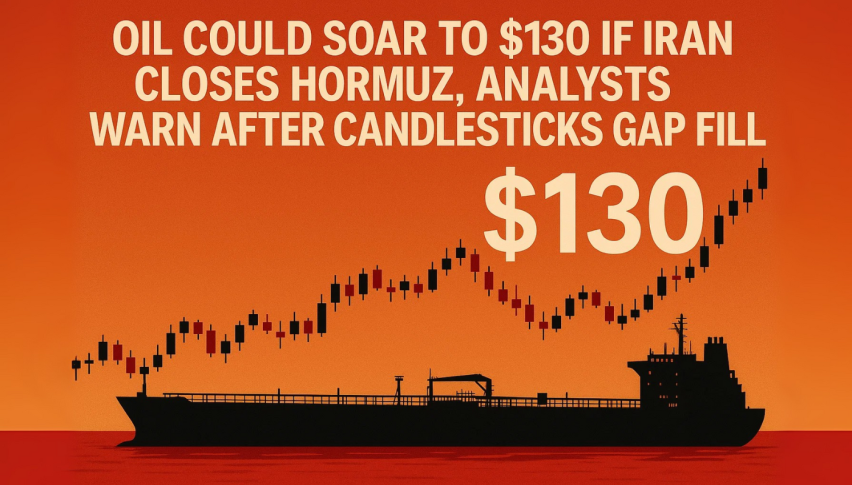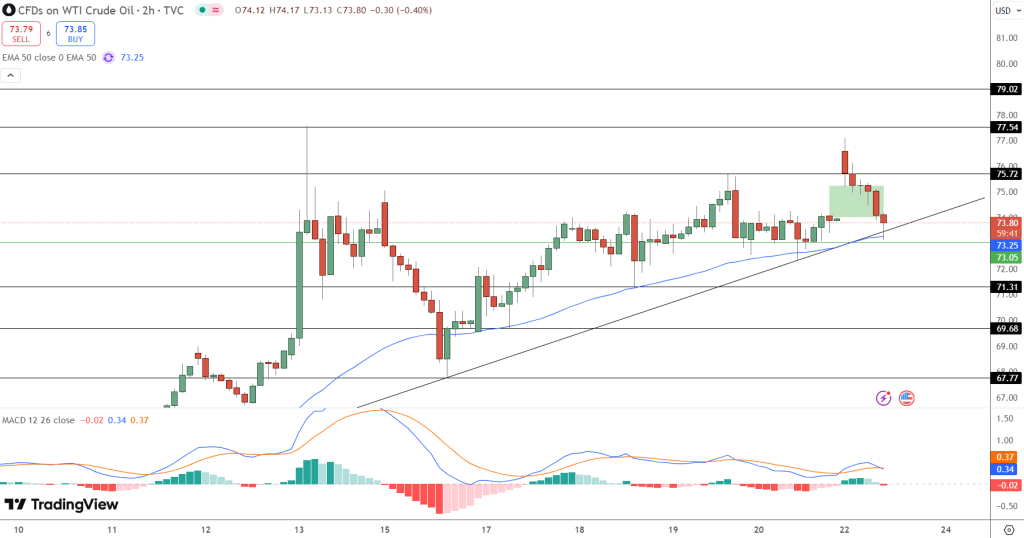Oil Could Soar to $130 If Iran Closes Hormuz, Analysts Warn After Candlestick Gap Fill
WTI crude oil opened this morning with a bullish gap, driven by weekend headlines that Iran’s parliament had approved a proposal...

Quick overview
- WTI crude oil opened with a bullish gap due to Iran's parliament approving a proposal to potentially shut the Strait of Hormuz.
- Prices briefly spiked to $75.72 before retreating to $73.80 as traders reassessed the risks following U.S.-Israeli strikes on Iranian nuclear sites.
- If Iran blocks the Strait, which handles 20% of global oil trade, prices could surge past $100, with worst-case scenarios reaching $130 per barrel.
- Traders are currently focused on key support at $73.05 and resistance at $75.72, as the threat of Iranian escalation keeps oil markets on edge.
WTI crude oil opened this morning with a bullish gap, driven by weekend headlines that Iran’s parliament had approved a proposal to shut the Strait of Hormuz. Prices briefly spiked to $75.72 before retreating to $73.80 as traders reassessed the risks. The initial surge reflected panic buying after U.S.-Israeli strikes on Iranian nuclear sites and rising fears of retaliation. However, the gap has now been fully filled—but analysts caution this may be a pause, not a peak.
If Iran follows through with its threat to block the Strait—a vital corridor for 20 million barrels per day or 20% of global oil—the market could see a price explosion. Some projections suggest WTI could climb past $100, with worst-case scenarios pushing it toward $130 per barrel.
Strait of Hormuz Risks Fuel Supply Concerns
WTI remains in focus as Iran’s next move could shake global energy markets. While the Strait of Hormuz proposal still needs approval from Iran’s Supreme National Security Council, its passage in parliament has already jolted sentiment.
At just 33 km wide at its narrowest, the Strait handles more than one-quarter of global seaborne oil trade, per U.S. Energy Information Administration data. Alternatives from Saudi Arabia and the UAE are limited and can’t replace full Hormuz capacity. Any disruption would spike insurance, shipping costs—and ultimately, oil prices.
WTI Technical Analysis: Trendline Holds—for Now
WTI crude (USOIL) filled its weekend gap and is testing major support around $73.25, where a key ascending trendline and the 50 EMA converge. This area could act as a springboard—or a trap door.

Key support and resistance levels:
- Support: $73.05, $71.31, $69.68
- Resistance: $75.72, $77.54
The MACD is flattening, and a bearish crossover is forming—indicating fading momentum. Still, this pullback may be a healthy reset within the broader uptrend.
Could Oil Really Hit $130?
According to Goldman Sachs and other analysts, if Iran moves to block Hormuz, oil could easily break $100, with $130 possible in a worst-case full-disruption scenario. Historical Gulf crises have added $15–$30 to oil prices within weeks.
Market reactions so far:
- Brent crude surged over 10% to $77
- Gold rose 2%, nearing $3,500 highs
- India’s 2M barrels/day via Hormuz could be at risk
India has ramped up Russian oil imports (now 38% of May 2025 intake) but remains vulnerable to global price spikes. Meanwhile, U.S. Secretary of State Marco Rubio warned that a closure of the Strait would be “economic suicide” and urged China to pressure Tehran.
Bottom Line
WTI crude has cooled, but the threat of Iranian escalation keeps oil markets on edge. For now, traders are watching $73.05 for breakdown risk and $75.72 for a breakout. If the Strait closes, $100 oil won’t be a shock—$130 could be next.
- Check out our free forex signals
- Follow the top economic events on FX Leaders economic calendar
- Trade better, discover more Forex Trading Strategies
- Open a FREE Trading Account


